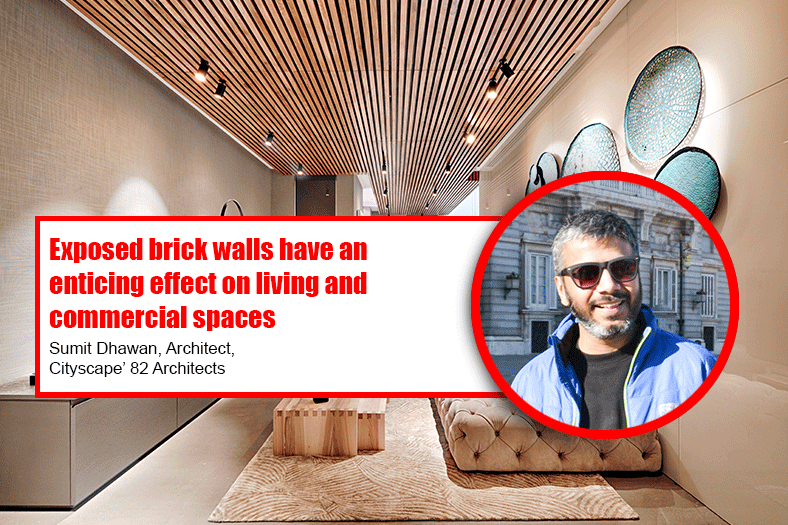Present day architecture is already governed by technology

Technology to a vast extent has accelerated real estate transformations and enhanced the role of architects as visionaries to urban planning.
Considering India in itself has a vast syntax of architecture and design, what in your opinion is the right definition for Indian Architecture and Design?
India as a land of socio-cultural diversity has always been witnessing organic growth in terms of the evolution of Architecture. Committing the versality and contextual diversity to a standard definition may not deliver justice to the practice. Needless to mention, globalisation has set in newer norms to building design in the country and added to the existing gamut of architectural styles that the skylines of Indian cities have witnessed.
Contextual response in architecture is the key to cater to diverse environmental/geographical factors across the country. Materiality and sustainable planning are key approaches to achieving an architectural solution to a contextual challenge in the manner that the building shall respond to occupant’s needs and its immediate wider environment. The tale of art and architecture dominated by the use of unconventional materiality continues to hold its relevance across the spectrum and more so in the Indian context!
This quote by the sculptor Henry Moore, holds true for architecture as a form of art as well, which goes to say:
“…one of the first principles of art so clearly seen in primitive work is truth to material; the artist shows an instinctive understanding of his material, its right use and possibilities.”
As we get globalised day by day, are we in the midst of an identity crisis in the architecture and design sense?
It’s an evolution that we’re going through as we are stepping into the future and identity crisis could be a grave misinterpretation of the phenomenon. While globalisation has enveloped the world, our role as architects has been to bring about spatial transformations capitalizing on the technological advancements and data science that globalization has allowed access to. Designing spaces that offer contextual relevance, contribute their share of iconism/monumentality to the location and yet be suited most empathetically to an unmatched inhabitant experience is what the endeavour seems like today!
When it comes to traditional Indian architecture, which project in your opinion is a landmark project?
Gandhi memorial museum designed by Charles Correa in Ahmedabad. The project delivers an incredible essence of architecture in the Indian context while designed to depict openness yet scalability, adaptive yet simple, and of course with human experience at the heart of it all!
When it comes to contemporary architecture, which project in your opinion reflects the inherent ‘Indianness’ in the present timeline?
There are quite a few projects that reflect an inherent Indianness in design. IIM Bangalore by BV Doshi has made its mark as a heritage for modern architecture in India. I’d like to draw the readers back to a quote by BV Doshi that beautifully conveyed his thought towards the project:
“I wanted to develop a system by which the buildings at IIM Bangalore disappear and spaces in between them dominate the experience of the place…I thought the most important things [were] the rasa, which is the subtle experience of the space that makes the space memorable. It extends the associations and enriches imagination.”
How much say will technology have in the future of architecture?
Present day architecture is already governed by technology which makes it imperative for technology to continue to mark an inherent role through building design. Technology to a vast extent has accelerated real estate transformations and enhanced the role of architects as visionaries to urban planning. Computational design has enabled us as architects to decipher and anticipate the performance of a building design in the context that it is being built and aid in highly optimised design decisions from the planning phase itself. UAVs (unmanned aerial vehicle) and data analysis programs can optimize the efficiency levels for complex building projects.
With the advent of cloud computing, it is only more cost effective to enable data driven practices that seamlessly integrate work flows to industry design software; we also have the benefit of drone data technologies for intelligence to be fed into the systems real-time.
Virtual Reality (VR) and Augmented Reality (AR) haven’t found reliance in their entirety within the Indian Architecture and Design domain but will continue to be on a rise. The intersection of art and architecture can also be met with much better application and precision through the use of automation tools and robotics, which also are gaining precedence in India.
Ar. Yatin Patel, Founder & Principal- DSP Design Associates, Education Design Architects (EDA)
22
Cookie Consent
We use cookies to personalize your experience. By continuing to visit this website you agree to our Terms & Conditions, Privacy Policy and Cookie Policy.









